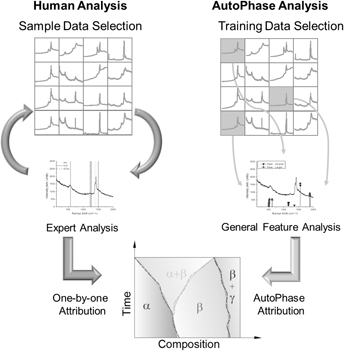Crossref Citations
This article has been cited by the following publications. This list is generated based on data provided by
Crossref.
Bunn, Jonathan Kenneth
Fang, Randy L
Albing, Mark R
Mehta, Apurva
Kramer, Matthew J
Besser, Matthew F
and
Hattrick-Simpers, Jason R
2015.
A high-throughput investigation of Fe–Cr–Al as a novel high-temperature coating for nuclear cladding materials.
Nanotechnology,
Vol. 26,
Issue. 27,
p.
274003.
Barron, S. C.
Patel, M. P.
Nguyen, Nam
Nguyen, N. V.
and
Green, M. L.
2015.
An apparatus for spatially resolved, temperature dependent reflectance measurements for identifying thermochromism in combinatorial thin film libraries.
Review of Scientific Instruments,
Vol. 86,
Issue. 11,
Strelcov, Evgheni
Yang, Sang Mo
Jesse, Stephen
Balke, Nina
Vasudevan, Rama K.
and
Kalinin, Sergei V.
2016.
Solid-state electrochemistry on the nanometer and atomic scales: the scanning probe microscopy approach.
Nanoscale,
Vol. 8,
Issue. 29,
p.
13838.
Hattrick-Simpers, Jason R.
Gregoire, John M.
and
Kusne, A. Gilad
2016.
Perspective: Composition–structure–property mapping in high-throughput experiments: Turning data into knowledge.
APL Materials,
Vol. 4,
Issue. 5,
Bunn, Jonathan Kenneth
Hu, Jianjun
and
Hattrick-Simpers, Jason R.
2016.
Semi-Supervised Approach to Phase Identification from Combinatorial Sample Diffraction Patterns.
JOM,
Vol. 68,
Issue. 8,
p.
2116.
Xiong, Zheng
He, Yinyan
Hattrick-Simpers, Jason R.
and
Hu, Jianjun
2017.
Automated Phase Segmentation for Large-Scale X-ray Diffraction Data Using a Graph-Based Phase Segmentation (GPhase) Algorithm.
ACS Combinatorial Science,
Vol. 19,
Issue. 3,
p.
137.
Chikyow, Toyohiro
2017.
Present status of the materials informarics and its challenge for future materials science.
Joho Chishiki Gakkaishi,
Vol. 27,
Issue. 4,
p.
297.
Suram, Santosh K.
Xue, Yexiang
Bai, Junwen
Le Bras, Ronan
Rappazzo, Brendan
Bernstein, Richard
Bjorck, Johan
Zhou, Lan
van Dover, R. Bruce
Gomes, Carla P.
and
Gregoire, John M.
2017.
Automated Phase Mapping with AgileFD and its Application to Light Absorber Discovery in the V–Mn–Nb Oxide System.
ACS Combinatorial Science,
Vol. 19,
Issue. 1,
p.
37.
Pradhan, Dhiren K.
Kumari, Shalini
Strelcov, Evgheni
Pradhan, Dillip K.
Katiyar, Ram S.
Kalinin, Sergei V.
Laanait, Nouamane
and
Vasudevan, Rama K.
2018.
Reconstructing phase diagrams from local measurements via Gaussian processes: mapping the temperature-composition space to confidence.
npj Computational Materials,
Vol. 4,
Issue. 1,
Xing, Hui
Zhao, Bingbing
Wang, Yujie
Zhang, Xiaoyi
Ren, Yang
Yan, Ningning
Gao, Tieren
Li, Jindong
Zhang, Lanting
and
Wang, Hong
2018.
Rapid Construction of Fe–Co–Ni Composition-Phase Map by Combinatorial Materials Chip Approach.
ACS Combinatorial Science,
Vol. 20,
Issue. 3,
p.
127.
Li, Shaobo
Xiong, Zheng
and
Hu, Jianjun
2018.
Inferring phase diagrams from X-ray data with background signals using graph segmentation.
Materials Science and Technology,
Vol. 34,
Issue. 3,
p.
315.
Vasudevan, Rama K.
Choudhary, Kamal
Mehta, Apurva
Smith, Ryan
Kusne, Gilad
Tavazza, Francesca
Vlcek, Lukas
Ziatdinov, Maxim
Kalinin, Sergei V.
and
Hattrick-Simpers, Jason
2019.
Materials science in the artificial intelligence age: high-throughput library generation, machine learning, and a pathway from correlations to the underpinning physics.
MRS Communications,
Vol. 9,
Issue. 3,
p.
821.
Oviedo, Felipe
Ren, Zekun
Sun, Shijing
Settens, Charles
Liu, Zhe
Hartono, Noor Titan Putri
Ramasamy, Savitha
DeCost, Brian L.
Tian, Siyu I. P.
Romano, Giuseppe
Gilad Kusne, Aaron
and
Buonassisi, Tonio
2019.
Fast and interpretable classification of small X-ray diffraction datasets using data augmentation and deep neural networks.
npj Computational Materials,
Vol. 5,
Issue. 1,
Terayama, Kei
Tamura, Ryo
Nose, Yoshitaro
Hiramatsu, Hidenori
Hosono, Hideo
Okuno, Yasushi
and
Tsuda, Koji
2019.
Efficient construction method for phase diagrams using uncertainty sampling.
Physical Review Materials,
Vol. 3,
Issue. 3,
Katsube, Ryoji
Terayama, Kei
Tamura, Ryo
and
Nose, Yoshitaro
2020.
Experimental Establishment of Phase Diagrams Guided by Uncertainty Sampling: An Application to the Deposition of Zn–Sn–P Films by Molecular Beam Epitaxy.
ACS Materials Letters,
Vol. 2,
Issue. 6,
p.
571.
Suzuki, Yuta
Hino, Hideitsu
Hawai, Takafumi
Saito, Kotaro
Kotsugi, Masato
and
Ono, Kanta
2020.
Symmetry prediction and knowledge discovery from X-ray diffraction patterns using an interpretable machine learning approach.
Scientific Reports,
Vol. 10,
Issue. 1,
Lee, Jin-Woong
Park, Woon Bae
Lee, Jin Hee
Singh, Satendra Pal
and
Sohn, Kee-Sun
2020.
A deep-learning technique for phase identification in multiphase inorganic compounds using synthetic XRD powder patterns.
Nature Communications,
Vol. 11,
Issue. 1,
Su, Ziyi
Liu, Handong
Qian, Jinwu
Zhang, Zhen
and
Zhang, Lunwei
2021.
Hand Gesture Recognition Based on sEMG Signal and Convolutional Neural Network.
International Journal of Pattern Recognition and Artificial Intelligence,
Vol. 35,
Issue. 11,
p.
2151012.
Chen, Di
Bai, Yiwei
Ament, Sebastian
Zhao, Wenting
Guevarra, Dan
Zhou, Lan
Selman, Bart
van Dover, R. Bruce
Gregoire, John M.
and
Gomes, Carla P.
2021.
Automating crystal-structure phase mapping by combining deep learning with constraint reasoning.
Nature Machine Intelligence,
Vol. 3,
Issue. 9,
p.
812.
Lee, Jin-Woong
Park, Woon Bae
Kim, Minseuk
Pal Singh, Satendra
Pyo, Myoungho
and
Sohn, Kee-Sun
2021.
A data-driven XRD analysis protocol for phase identification and phase-fraction prediction of multiphase inorganic compounds.
Inorganic Chemistry Frontiers,
Vol. 8,
Issue. 10,
p.
2492.





